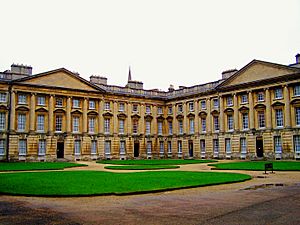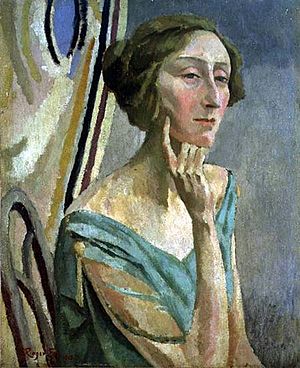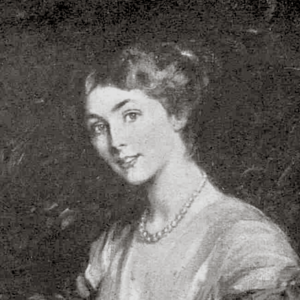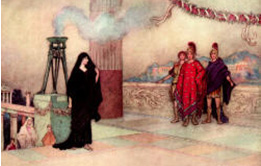William Walton facts for kids
Sir William Turner Walton (born March 29, 1902 – died March 8, 1983) was a famous English composer. He wrote many different kinds of music over 60 years, from movie scores to operas. Some of his most well-known works include Façade, the big song piece Belshazzar's Feast, his Viola Concerto, his First Symphony, and the coronation marches Crown Imperial and Orb and Sceptre.
Walton was born in Oldham, Lancashire. His father was also a musician. William sang in a choir and later studied at Christ Church, Oxford. After university, he was helped by the Sitwell family, who gave him a home and taught him about culture. His first important work, Façade, was made with Edith Sitwell. It was seen as very modern at first, but later became a popular ballet.
When he was older, Walton moved to the Italian island of Ischia with his wife, Susana. By this time, some people thought his music was old-fashioned. His only full opera, Troilus and Cressida, was one of these works and is not often performed. However, later in his life, his music became popular again. Many of his works are still performed today, and almost all of them are available on CD.
William Walton's Early Life
Growing Up with Music
William Walton was born into a family that loved music in Oldham, Lancashire. His father, Charles Alexander Walton, was a music teacher and church organist. His mother, Louisa Maria, was a singer. William showed musical talent from a young age. He took piano and violin lessons, but he was best at singing. He and his older brother sang in their father's choir. They performed big pieces by famous composers like Handel and Haydn.
In 1912, when William was ten, his father saw an ad for choir singers at Christ Church Cathedral School in Oxford. William was accepted, even though his family had trouble getting there. He stayed at the choir school for six years. The head of Christ Church, Dr. Thomas Strong, noticed William's talent. Even the famous composer Sir Hubert Parry saw some of Walton's early music and said, "There's a lot in this chap."
University Days
At 16, Walton became a student at Christ Church, Oxford. He was one of the youngest students there. He learned a lot from Hugh Allen, a key person in Oxford's music scene. Allen showed Walton modern music, like Stravinsky's Petrushka. Walton spent a lot of time in the library, studying music by Stravinsky, Debussy, and others. He did well in music but struggled with other subjects like Greek and algebra. He left Oxford in 1920 without a degree.
Not much of Walton's early music still exists. But a song for choir called A Litany, which he wrote at 15, already showed hints of his later style.
While at Oxford, Walton became friends with poets like Siegfried Sassoon and, most importantly, Sacheverell Sitwell. After leaving Oxford, Sitwell invited Walton to live with him and his brother and sister, Osbert and Edith, in London. Walton lived in their attic for about 15 years.
Walton's First Big Hits
Living with the Sitwells
The Sitwell family helped Walton a lot. They gave him a home and taught him about art and culture. He took music lessons and met famous musicians like Stravinsky and Gershwin. He even wrote an experimental string quartet that was played at a music festival in Salzburg in 1923. The composer Alban Berg was impressed and introduced Walton to Arnold Schoenberg, another very important composer.
The Façade Premiere
In 1923, Walton had his first big success with Façade, which he created with Edith Sitwell. It was first performed in London. Edith read her poems through a megaphone from behind a screen, while Walton conducted six musicians. At first, many critics did not like it. One newspaper called it "Drivel That They Paid to Hear." But some people, like Edward J. Dent, saw the serious side of the work. Ernest Newman called Walton "a jewel of the first water" as a musical joker.
Famous people like Evelyn Waugh and Virginia Woolf were in the audience. Noël Coward was so upset by the modern style that he walked out. Even the musicians found it strange. But Façade soon became popular. Within ten years, Walton's music was used for a famous ballet called Façade, choreographed by Frederick Ashton.

During the 1920s, while living with the Sitwells, Walton wrote other pieces. One was the overture Portsmouth Point, inspired by a painting of a busy dockside. It was first played in 1926. Later, Sir Henry Wood played it at the Proms concert series, where it made a bigger impression. Walton conducted this performance himself. He didn't love conducting, but he knew how his music should sound.
Becoming Well-Known
Walton's Viola Concerto (1929) made him a leading British composer. It was meant for a famous viola player, Lionel Tertis, but he didn't like it at first. So, another composer and viola player, Paul Hindemith, played it instead. People loved it! One critic said, "This young composer is a born genius." Tertis later changed his mind and performed the piece often.

Walton's next big work was the huge choir piece Belshazzar's Feast (1931). It started as a small project for the BBC, but Walton's music needed much more power. Sir Thomas Beecham helped him by arranging for it to be played at the 1931 Leeds Festival. Beecham even joked, "As you'll never hear the work again, my boy, why not throw in a couple of brass bands?" The first performance was a huge success. Many people felt that a great new composer had arrived. This work is still a very important piece for choirs today.
Life in the 1930s
In the 1930s, Walton became less close to the Sitwells. He started new relationships and friendships. One important relationship was with Alice, Viscountess Wimborne, which lasted from 1934 until she passed away in 1948. By this time, Walton was earning enough money from his music to live on his own. In 1934, he moved out of the Sitwells' house and bought his own home in London.
Walton's first major work after Belshazzar's Feast was his First Symphony. He worked on it slowly from 1931 to 1935. He finished the first three parts by 1933 but then got stuck. This might have been because his relationship with Imma von Doernberg ended. The conductor Hamilton Harty performed the first three movements in 1934. Walton then finished the symphony in 1935.
The complete symphony was first played in November 1935 and became famous around the world. Important conductors from other countries wanted to play it.

After Elgar passed away in 1934, Walton was asked to write a march for the coronation of King George VI in 1937. His march, Crown Imperial, was an instant hit with the public. Walton also wrote music for movies, including As You Like It (1936). His most important work of the 1930s, besides the symphony, was the Violin Concerto (1939). It was asked for by the famous violinist Jascha Heifetz. Walton said this concerto showed his love for Alice Wimborne. Some critics thought it sounded old-fashioned, but it is now a beloved piece.
In the late 1930s, Walton met Benjamin Britten, a younger English composer who would soon become very famous. They remained friends throughout Britten's life. Walton admired Britten's music, and Britten was thankful for Walton's support.
World War II and Beyond
Wartime Music
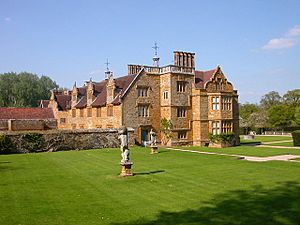
During World War II, Walton was asked to write music for propaganda films. He also drove ambulances. He wrote music for six films, including classics like The First of the Few (1942) and Laurence Olivier's Henry V (1944). At first, Walton didn't think his film music was very important. He believed film music should only be for films. But later, he allowed some of his film music to be arranged for concerts.
Walton's house in London was bombed in 1941. After that, he spent a lot of time at Alice Wimborne's family home in the countryside. While there, he worked on a string quartet. He knew that Britten was creating many important works, and Walton hadn't written a major piece since his Violin Concerto in 1939. The String Quartet in A minor, first played in 1947, was his most important work of the 1940s. Many people now see it as one of his best pieces.
Life After the War
In 1947, Walton received a special award called the Royal Philharmonic Society's Gold Medal. That same year, the BBC asked him to write his first opera. He decided to base it on Chaucer's story Troilus and Criseyde. But his work stopped in 1948 when Alice Wimborne passed away. To help him feel better, a music publisher convinced him to go to a meeting in Buenos Aires. There, Walton met Susana Gil Passo, who was 24 years younger than him. He fell in love and they got married in December 1948. From then on, they spent half the year on the Italian island of Ischia, and later lived there full-time.

Walton's last work of the 1940s was music for Olivier's film Hamlet (1948). After that, he focused on his opera Troilus and Cressida. In 1951, he was made a knight, so he became Sir William Walton. In 1953, for the coronation of Elizabeth II, he wrote another march, Orb and Sceptre, and a choir piece called Te Deum.
Troilus and Cressida was first performed in London in 1954. It had many problems during its creation. The opera was not a big success. Many felt it was old-fashioned. It was played in other cities but never became a regular part of opera shows.
In 1956, Walton sold his London house and moved to Ischia permanently. He built a house called La Mortella, and Susana created a beautiful garden there. Walton also wrote music for Olivier's film Richard III and his Cello Concerto (1956). Some critics thought the Cello Concerto was old-fashioned too, but it is now a popular piece played by many famous cellists.
In 1966, Walton had surgery for a health issue and stopped smoking. While recovering, he wrote a funny one-act opera called The Bear. It was very well received. In 1967, Walton received the Order of Merit, a very high honor.
His other works from the 1960s include his Second Symphony (1960) and pieces inspired by other composers like Paul Hindemith and Benjamin Britten. He also wrote music for the film Battle of Britain (1969), but most of his music was not used in the final movie. After this, he said he wouldn't write film music anymore, but he was convinced to write one more for Olivier's film Three Sisters (1969).
Walton's Final Years
Walton was always a slow composer, and in his last ten years, writing music became even harder. He tried to write a third symphony but never finished it. Many of his later works were new versions of his older music. One new piece from this time was Jubilate Deo, written for his 70th birthday. Many events celebrated his birthday, including a dinner with the Prime Minister and concerts.
Walton revised his opera Troilus and Cressida, and it was performed again in 1976. But it still didn't become popular. In his last years, Walton worked with filmmaker Tony Palmer. He appeared in a film about himself and even played a small role in Palmer's film Wagner in 1982. In March 1982, there were concerts for his 80th birthday. The audience's reaction to Belshazzar's Feast made him cry.
Walton passed away at his home in Ischia on March 8, 1983, at age 80. His ashes were buried on the island. A special stone was placed for him in Westminster Abbey near other great English composers.
Walton's Musical Style
Walton worked slowly and carefully on his music, always making changes. Because of this, he didn't create a huge number of pieces over his 60-year career. For example, between 1923 and 1928, he wrote only about one small piece each year.
Walton's music is known for its strong rhythms, beautiful sad parts, clever charm, and exciting orchestral sounds. Even though some critics thought his later music wasn't as good as his early works, many now believe his later pieces are deeper and more meaningful.
Orchestral Music
Overtures and Short Pieces
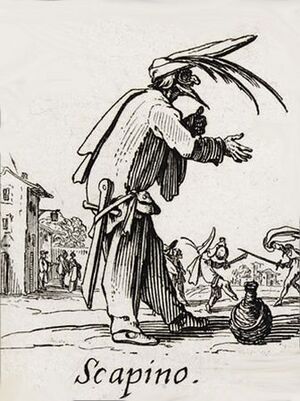
Walton's first piece for a full orchestra was Portsmouth Point (1925). It's a lively piece that sounds like a busy dockside scene, full of exciting rhythms. It was quite difficult for orchestras to play for many years! He wrote other similar lively pieces, like the Comedy Overture Scapino, which was praised for its clever mix of musical ideas. His later short pieces include Variations on a Theme by Hindemith (1963) and Improvisations on an Impromptu of Benjamin Britten (1969), where he took music by other composers and slowly changed it into his own style.
Concertos and Symphonies
Walton's first big concert success was the Viola Concerto (1929). It's much calmer than Portsmouth Point and has a romantic, longing feeling, similar to Elgar's Cello Concerto. Walton continued this style in his Violin Concerto (1937) and Cello Concerto (1956). Each of these concertos starts thoughtfully and has three movements, mixing fast, exciting parts with warm, romantic sections. The Cello Concerto is more thoughtful, with a steady rhythm that makes you think of time passing.
Walton's two symphonies are very different. The First Symphony is a large, powerful piece, sometimes reminding people of Sibelius. It's known for its strong energy and exciting sounds. Critics have often debated if the ending of the First Symphony is as good as the rest of it. The Second Symphony (1960) felt lighter to many people when it first came out, and some thought it was old-fashioned. It's a more personal and calm piece than the First Symphony, showing Walton's more mature style.
Music for Ballets, Plays, and Films
Walton could work very quickly when he needed to, especially for stage and film music. He often thought these pieces were less important than his concert works.
His ballet The Wise Virgins (1940) uses music by J. S. Bach that Walton arranged. The Quest (1943) was written very fast. Neither of these ballets became as famous as the ballet version of Façade, which kept the jazz influences and clever humor of the original.
Walton wrote music for 13 films between 1934 and 1969. He created the famous Spitfire Prelude and Fugue from his music for the film The First of the Few (1942). He also allowed parts of his music for Shakespeare films, like Henry V, to be made into concert suites. In these films, he mixed old English sounds with his own unique style. The music for the Agincourt battle in Henry V is especially praised for making the French knights' charge feel very real.
Opera
Walton spent many years on his only full-length opera, Troilus and Cressida. However, it has never been a big success. Many critics feel the story is weak, and even though Walton's music has many beautiful parts, it's not dramatic enough to keep people interested for a whole opera.
Walton's other opera, The Bear, is a short, funny opera based on a play by Chekhov. Critics think it is much more successful. But because it's a one-act opera, it's not performed as often in big opera houses.
Chamber and Solo Works
Walton wrote a String Quartet in A Minor (1945–46) and a Sonata for Violin and Piano (1947–49). Many people now consider the String Quartet to be one of his greatest achievements. The String Quartet was later made into a larger piece called the Sonata for String Orchestra (1971), which combines Walton's energetic rhythms with his gentle, lyrical side.
The Violin Sonata has two parts that are closely related. The first part is a bit nostalgic and lyrical. The second part is a series of variations, where the music changes slightly each time.
Walton also wrote Five Bagatelles for Guitar for the famous guitarist Julian Bream.
Choral and Other Vocal Music
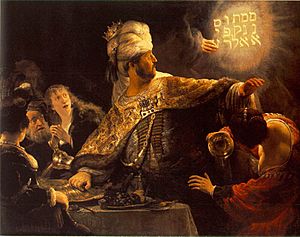
Walton wrote several pieces for church services, including the Coronation Te Deum (1952) and Jubilate Deo (1972).
One of Walton's most famous and often performed works is the cantata Belshazzar's Feast. It's written for a large orchestra, choir, and a solo singer. It tells the story of a wild party in ancient Babylon, with exciting, jazzy music, and then the sadness and joy of the Jewish people. It's considered one of the most important English choir works since Elgar's The Dream of Gerontius. None of Walton's later choir pieces became as popular as Belshazzar's Feast.
Recordings
Walton's music has been recorded a lot, even back when records were new. In 1929, the Decca company recorded parts of Façade, with Walton himself conducting. Later, his First Symphony and Viola Concerto were also recorded. In the 1940s, Walton moved to EMI, a bigger record company. They made many recordings of his major and minor works.
Walton, even though he didn't love conducting, led many of these recordings. He recorded his First Symphony, concertos, Façade Suites, Belshazzar's Feast, and music from his film scores.
Almost all of Walton's music has been recorded. EMI released a special "Walton Edition" of his works on CD in the 1990s. His most famous pieces, like Belshazzar's Feast, the Viola and Violin Concertos, and the First Symphony, have been recorded by many musicians from different countries.
See also
 In Spanish: William Walton para niños
In Spanish: William Walton para niños



